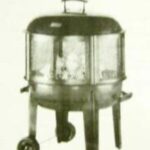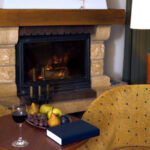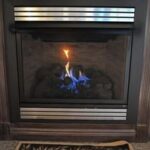Building a fire for the first timer may seem intimidating, but once you try it a few times, and get the hang of it, its a snap! It is actually a lot like art. Everyone has their different way of expressing themselves, and putting their fire together. The end result is something beautiful, that keeps you and your loved ones warm, invites stimulating conversation, and casts a romantic, pleasant light about the room.
Preparation is the key when you are thinking about building a fire. Safety should be of utmost concern. The first thing you will need to do is examine your fireplace and chimney. You want to get a flashlight and look up into the chimney to make sure there are no animal nests, or blockages of the flue. You also want to avoid building a fire in a fireplace that has a heavy buildup of creosote. A chimney sweep should come to your home once a year to inspect and clean your chimney, and make sure that everything is in good working condition. Once this safety inspection is completed, you are ready to proceed.
Now you will need to have several tools. You’ll need to have a cast iron grate for your fireplace, or andirions, if you prefer. Great used andirions can be found on ebay.com. Many people prefer to use andirions because of the more classic, old-school burning style. I like the appearance of them, but once a log burns in the middle, it will collapse between them, rendering itself useless for further burning. Therefore, I find that the cast iron grate is the best log holder to go with. It maximizes the usefulness of your logs, and increases their burning life. A fireplace screen is also a must. This screen will protect you and your floor from wayward sparks, and on the off chance that a log should roll out. You will also need to have a good pair of gloves, for handling wood and hot fireplace doors. An added bonus is a fireproof rug that you can place on the floor in front of the fireplace. This prevents your rug from getting any tiny singes from sparks. Lastly, you will want to have a nice set of fireplace tools, which usually include a poker, shovel, and brush on an attractive stand.
The next thing you will need is some wood for your fire. You will need some logs or larger pieces of wood, some medium sized, such a large limbs which have been broken up, and kindling wood or fat wood. Many places will try to sell you specialty kindling wood in a cute package for a lot of money. I would avoid that and just go pick up sticks in your yard, if you have that option available to you. You’ll also want to have on hand some sheets of newspaper, twisted up into “logs” and a lighter or matches. Other good things to have around for safety’s sake are a container of water, a fire extinguisher, and make sure your smoke alarms are working properly.
Gather your wood for the fire. You can buy this wood already split and cut up at grocery stores, and hardware stores. Or you can buy it by the truckload from someone who sells in bulk. Another solution is that if you live on land with a lot of trees, you can cut up trees when they fall, and use them later for firewood. Make sure that your wood is seasoned and dry. Cutting up wood and letting it “cure” out in the sun and rain for six months to one year’s time, is the best way to season wood. Green, new wood, tends to not burn so well, and just smokes up the place. Hardwoods, such as oak and hickory, burn the best. Softwoods, like pine, should only be used to light the fire, in such uses as for kindling. Pine lights and burns fast. It also contains a lot of sap, which can get hot and coat the inside of your chimney with creosote. Over time, this buildup can be hazardous and could lead to a chimney fire, so use pine with caution.
When you begin to build your fire, take your balled up newspaper and put some of it underneath the grate. Then, on top of the grate, place a few pieces of kindling wood. Then place a larger piece of wood up against the back wall of the fireplace, and a larger one more toward the front. Then in the middle, place some more kindling, combined with medium sized pieces of wood. Then you can tuck a few pieces of the twisted up newspaper here and there, to encourage everything to light evenly. Make sure your chimney damper is open, probably about half way, so the air will go up, and not into your house. Then light a piece of the twisted newspaper on one end, and hold it above the wood, towards the inside of the chimney. This heats up the air and encourages the air to go up. Do this for a few seconds, and then light your fire. It should start up very nicely.
Your fire will lap up all the kindling and paper at first, and be a hot, lively fire, and then after a while it will settle down. You can keep an eye on it, and when it dies down some, you can poke at it a little with your poker, and kind of rearrange the wood a bit, so that it gets more oxygen. Often, just this action, will reignite those lively flames and have it burning with vigor again. If this does not do the trick, then you may need to add more wood. When you add more wood, follow the same pattern you had at the beginning. Put a larger piece in back, and a larger one in front. Take the older back and front pieces and push them towards the center. Then add some more medium sized pieces to the center, and this will re-heat the fire. Try to avoid simply piling one log atop another, as this will smother the fire. The fire needs air to keep burning at a good rate, so arranging the logs in the fashion I described will help keep this in place.
It goes without saying that you should not leave a burning fire unattended. When you have a fire in your fireplace, you always need to put safety first. Do not leave anything flammable or combustible within the vicinity of the fireplace. And never add flammable fluids to the fire, such a lighter fluid. Inspect your chimney regularly, both inside and out, to make sure everything is looking good. Remember to consult a chimney sweep once a year for a cleaning, if you use your fireplace regularly. Remove ashes regularly from the bottom of the fireplace. The ash bed should be no more that two inches. I have often heard than once inch left is good as an insulator. When you do remove ashes, make sure they have been sitting, without any fire, for at least a day or two. You will need a metal bucket and metal shovel to remove them. Place the ashes in the metal bucket and place it somewhere safe outside and away from the house and trees, any flammable materials, etc. Let the ashes sit for a few days to make sure there are no more hot embers left. And to make doubly sure, you can always pour some water over them. Then when all is clear, you may dispose of the ashes, by putting them in a compost pile, or putting them in a special area you have created just for ash remains.
Building an excellent fire truly is an art form. As you practice building and maintaining a fire more and more, you will learn what works best for you, and add your own personal touches to make fire building your own personal artwork. Nothing warms up a home more, both literally and figuratively than to have a warm, toasty fire with a hearth for friends and family to enjoy. You can start a fire in the morning, and have it burn into the evening, where, when the lights are dimmed, the lovely embers and wonderful sounds add a wonderful ambiance to any room. Remember, practice makes perfect, and put safety first, and you will always have warm, safe and beautiful fires to enjoy and keep your family warm throughout the cooler days of the year.




